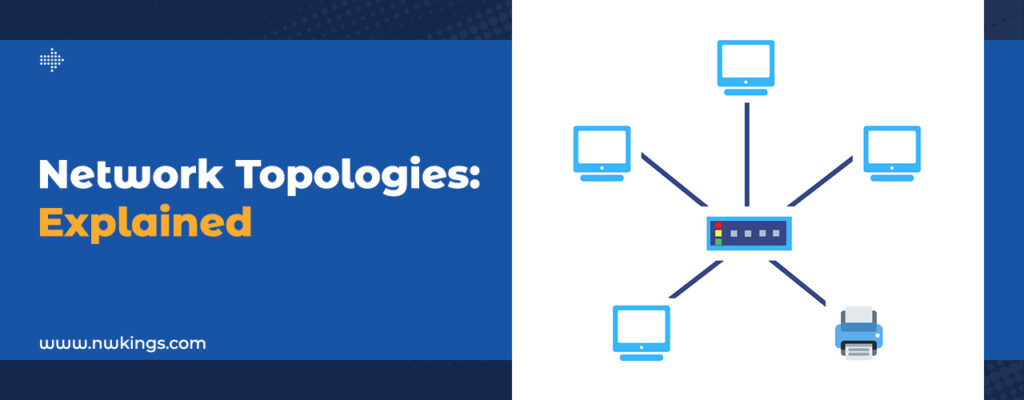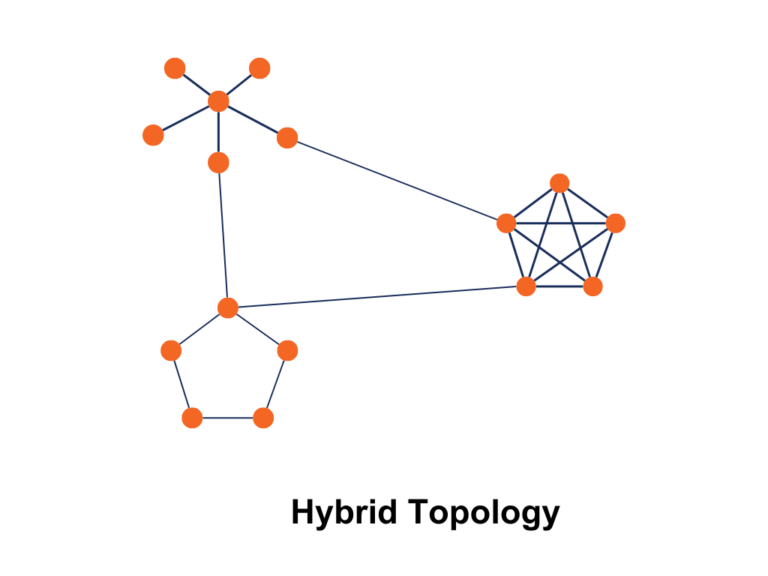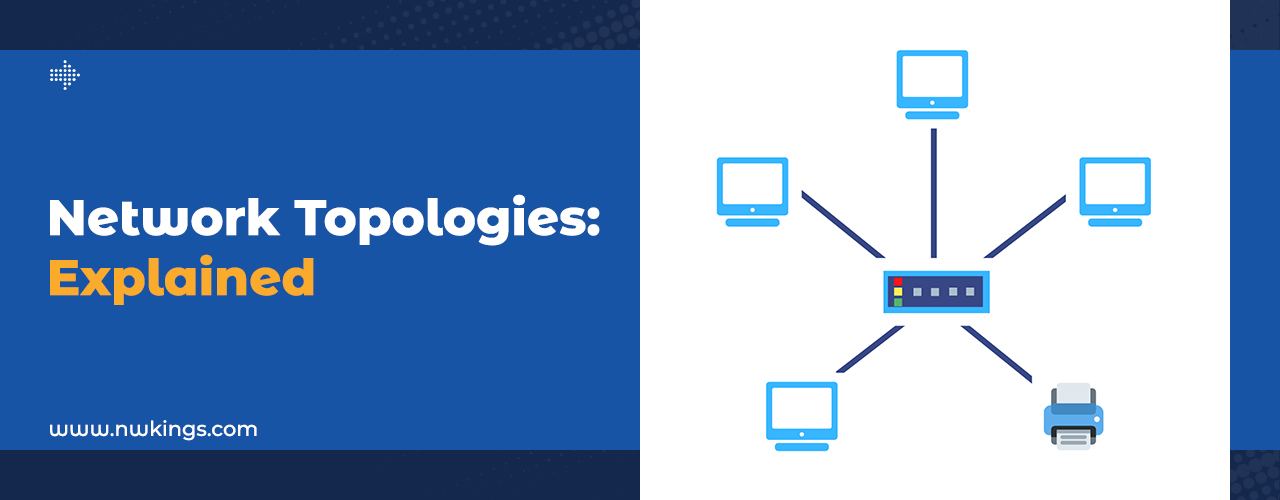
Network devices can get connected in different ways. The structure that defines how devices are connected is known as TOPOLOGY.
Network Topology defines how devices, systems, and nodes are connected physically and logically to each other, impacting the efficiency, reliability, and security of communication infrastructure.
Nodes are the switches and routers used to connect devices.
Network Topology is often represented graphically. Using graphs and diagrams one can determine the best placement of nodes. If you plan the placement of nodes well, the network efficiency increases. Also, the faults can easily be located resulting in a well-managed network.
What are the different kinds of Network Topology?
Network topology is an important factor in network designing as it allows the network to work efficiently and makes it easier to detect faults and troubleshoot them.
The diagram includes dots and lines. Dots represent nodes, while lines represent connections (maybe ethernet cable or wireless connections).
The kinds of Network Topology are as follows-
- Mesh Topology
- Bus Topology
- Star Topology
- Ring Topology
- Tree Topology
- Hybrid Topology
What is Mesh Topology?

- Mesh Topology
In this topology, each node gets connected to every other node, providing multiple paths to reach a particular node.
Total ports required – Suppose we have N devices connected. The ports required per device will be N-1.
In Figure 4, devices are connected. Hence, the ports required are 4-1 = 3
Total links required – For N devices connected, the total number of links required is N(N-1)/2
For N=4, links required = 6
What are the disadvantages of using the Mesh Topology?
The disadvantages of using the Mesh Topology are as follows-
- Requires many cables hence cost increases
- High maintenance cost
- Not Flexible
- Poor expandability
Mesh topology is not expandable. If we need to add an extra node, it must be connected to each of the existing nodes via the dedicated link shown in the figure. For the same reason, the cost of cabling will be very high for a larger area. And due to this reason, this topology is rarely used.
What is Bus Topology?

- Bus Topology
In this topology, data is transmitted between nodes using a common transmission medium, and all the nodes receive it simultaneously. In this topology, data flow is bidirectional since it can send and receive data.
A hardware interface, known as TAP, is used to connect the node to the transmission medium. At the end of the transmission medium, terminators get connected, which absorb the data and signals. If it fails, the endpoints would act like a mirror and transmit each signal back and forth causing network congestion.
The transmission medium is generally known as the backbone cable. Only coaxial and twisted pair cables are used. Generally, the cost for this topology is low. It is also flexible to add a new node.
What are the disadvantages of using the Bus Topology?
The disadvantages of using the Bus Topology are as follows-
- Since it has one common cable to transmit data, if it fails, the whole system fails.
- As number of devices increases, network speed decreases.
What is Star Topology?

In this topology, each workstation is connected to a single node shown in the figure. The central node, known as the star coupler, is joined via two point-to-point links. One link is for transmission, while the other is used for reception. In the case of a star topology, all traffic passes through the central node (hubs and switches).
If one link fails, it does not affect other workstations but itself. Fault detection in the case of star topology is easy. Star topology is easy to design and has a centralized management system. Most office and home networks have star topology.
What are the disadvantages of using the Star Topology?
The disadvantages of using the Star Topology are as follows-
- If the hub or switch fails, the whole system fails.
- This may result in an overloaded hub or switch.
- Due to the use of a hub or switch, cost increases.
Total Ports required: – For each device, 1 port is required.
Total links required: – To connect N devices, the number of links required is also N.
What is Ring Topology?

In this topology, nodes are connected in a closed loop, which is why it is called a ring topology.
In some cases, the ring passes data in one direction only, while in some, it can pass data in both directions and traffic can reach a node using either direction.
Repeaters are used with topology having many nodes. Because, with let’s say 50 nodes, the signal must pass from all 48 nodes to reach the 49th node, and hence the strength of the signal reduces. To prevent data loss, we use repeaters.
What are the disadvantages of using the Ring Topology?
The disadvantages of using the Ring Topology are as follows-
- If an error arises, it becomes difficult to troubleshoot.
- Single-node failure can lead to the failure of the entire network.
- The addition of a workstation or removal of the workstation is complicated.
What is Tree Topology?

In this topology, we have a root node that connects other secondary nodes and workstations resembling a tree.
There is a central node (like a trunk), and each node and workstation can be considered as its branches and leaves. This topology is highly scalable, easy to expand, and supports many nodes and workstations.
What are the disadvantages of using the Tree Topology?
The disadvantages of using the Tree Topology are as follows-
- Failure in the root node can cause lead to the entire system failure.
- Troubleshooting is difficult due to lots of nodes.
- It requires more cabling and switches (nodes), which makes it costlier.
What is Hybrid Topology?

When a topology comprises two or more types of topologies connected, it is called Hybrid Topology.
It is a combination of different types of topologies and is used when we need to connect large networks in a way that makes it efficient. Mostly Star and Ring topology is used to create a hybrid topology, but other topologies like Bus, Mesh, and Tree can also get integrated.
Hybrid topology is very flexible and scalable. In this topology addition of an extra node or workstation is quite easy. It is mostly used in universities and schools since it is flexible. Hence each department can design its network according to the use and can remain connected.
What are the disadvantages of using the Hybrid Topology?
The disadvantages of using the Hybrid Topology are as follows-
- This topology is difficult to design.
- Since a lot of different topologies are connected, and hence we have a lot of workstations, expensive hubs are needed for this topology which increases its cost.
- It is difficult to manage.


